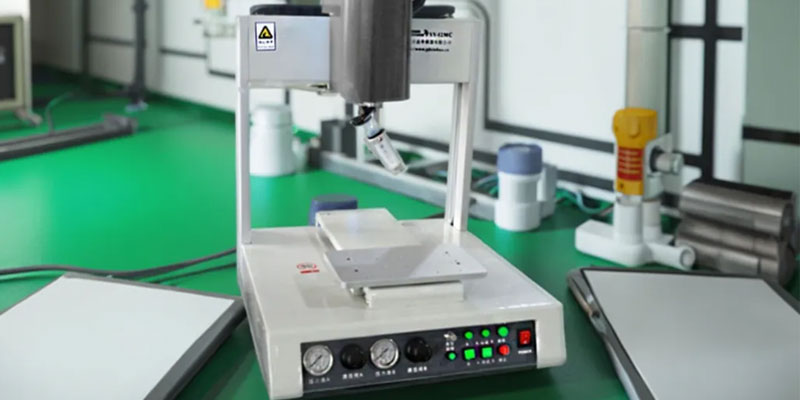Automated adhesive dispensing system have revolutionized manufacturing by enhancing precision, efficiency, and consistency in adhesive application. These systems integrate advanced subsystems—material supply, metering units, applicators, controllers, and customizable options—to handle diverse viscosities and application patterns across industries such as automotive, electronics, and aerospace. By leveraging robotics and programmable parameters, they minimize human error, reduce material waste, and adapt to complex geometries, supported by innovations like viscosity monitoring and Industry 4.0 connectivity. This guide explores their components, operational methodologies, and sector-specific implementations, underscoring their transformative impact on modern production lines
System Architecture and Core Components
Automated adhesive dispensing system comprise five interconnected subsystems that ensure precise material delivery and application. Each subsystem plays a critical role in maintaining process integrity and adaptability.
Material Supply Subsystem
The material supply subsystem transfers adhesives from containers to the metering unit or applicator. Containers vary from 310 mL cartridges to 1,000 L barrels, selected based on production scale and material viscosity. Displacement pumps generate pressure to convey materials through hoses, while heated or unheated configurations prevent premature curing or viscosity fluctuations. For instance, thermosetting adhesives like epoxies require heated barrels to maintain flowability, whereas cyanoacrylates (CAs) benefit from closed systems that minimize air exposure. Advanced units incorporate low-level sensors to trigger refill alerts, reducing downtime.
Metering Unit
Metering units regulate adhesive volume dispensed per cycle, ensuring consistency across applications. Gear meters and piston meters are common, with the former ideal for low-viscosity fluids (e.g., silicones) and the latter for high-viscosity pastes (e.g., PVC sealants). Precision is achieved through digital controllers that adjust stroke length or rotational speed, often calibrated to tolerances within ±1% of target volume.The LOCTITE EQ RC30 controller, for example, uses programmable timing channels to manage dot or bead dispensing, with pressure regulators maintaining 0–7 bar outputs for uniform flow.
Applicator Technologies
Applicators determine bead geometry and deposition accuracy. Nozzle-based systems dominate, with designs tailored to specific patterns:
Round bead nozzles produce diameters of 1–8 mm for structural bonding in automotive body panels.
Swirl applicators use air or electric streams to disperse adhesives like polyurethanes for windshield glazing, achieving widths up to 200 mm.
Flat stream nozzles deposit thin, wide layers (≤0.4 mm) for underbody corrosion protection, operating at robot speeds of 300–600 mm/s.
Non-contact jetting valves, such as Xinhua High Speed Intelligent Automated Glue Dispensing Machine series, enable high-speed dispensing of cyanoacrylates without nozzle-part contact, critical for delicate electronics assembly
System Controller
Controllers synchronize subsystems via programmable logic controllers (PLCs) or human-machine interfaces (HMIs). They store parameter sets for different adhesives and geometries, allowing rapid changeovers. For example,Xinhua’s controllers integrate real-time viscosity monitoring, automatically adjusting temperature or pressure to maintain optimal flow characteristics.Modern systems also support Industry 4.0 protocols, enabling remote diagnostics and predictive maintenance through Wi-Fi or Ethernet.
System Options
Enhancements like tool changers, vision systems, and purge stations extend functionality. CCD Vision-guided robots correct path deviations in real-time during windshield sealing, while suck-back valves prevent dripping after dispensing cycles.
Adhesive Types and Viscosity Considerations
Material properties dictate subsystem design and operational parameters.
Low-Viscosity Adhesives (≤5,000 cP)
Cyanoacrylates and UV-curing acrylates require minimal pressure (1–3 bar) and benefit from diaphragm valves that prevent air entrapment. Nordson’s 752V-UHSS valve, with a UHMW polyethylene fluid body, resists curing inhibitors and offers stroke control for precise droplet sizes.
Medium-Viscosity Adhesives (5,000–50,000 cP)
Epoxies and silicones demand gear meters and heated hoses (up to 160°C) to reduce viscosity. Piston meters with servo-driven actuators achieve repeatability within ±0.5% for automotive seam sealing.
High-Viscosity Adhesives (≥50,000 cP)
PVC-based sealants and rubber adhesives necessitate high-pressure (5–7 bar) piston meters and wide-bore nozzles. The LOCTITE 97111 applicator, equipped with a 3/8″ feed line, handles viscosities up to 80,000 cP, while anti-ballooning algorithms compensate for hose expansion under pressure.
Application Techniques and Quality Assurance
Bead Geometry Control
Stitch Beading: Intermittent adhesive dots (0.2–6 mm diameter) reinforce welded joints in chassis assembly. Controllers regulate dot spacing and robot speed (200–500 mm/s) to prevent overflow.
Swirl Patterns: Electrically charged airstreams disperse polyurethanes into fan-shaped coatings for sunroof seals, with width adjusted via nozzle oscillation.
Airless Spraying: Hydraulic pumps atomize rubber coatings for underbody protection, achieving 350 mm widths at 600 mm/s traversal speeds.
In-Process Monitoring
Integrated sensors detect air bubbles or viscosity drifts, triggering purge sequences to clear blockages. Statistical process control (SPC) software logs cycle times and deviations, enabling root-cause analysis for defects.
Industry-Specific Implementations
Automotive Manufacturing
Robotic dispensers apply structural adhesives to aluminum panels, replacing spot welds to reduce weight.
Electronics Assembly
Micro-dispensing valves place 0.1 mm³ dots of conductive adhesive on PCB connectors.
Aerospace
Two-part epoxy fillets bond composite wing sections, dispensed at 60°C to extend open time. CNC-guided applicators follow 3D CAD paths, with laser scanners verifying bead dimensions against tolerances of ±0.1 mm.
Automated adhesive dispensing systems represent a convergence of mechanical engineering, materials science, and digital control. By optimizing subsystem interoperability and adopting adaptive technologies like AI-driven parameter optimization, manufacturers achieve unprecedented precision and scalability. Future advancements will focus on self-calibrating systems and biodegradable adhesives, further aligning with sustainable production goals.





